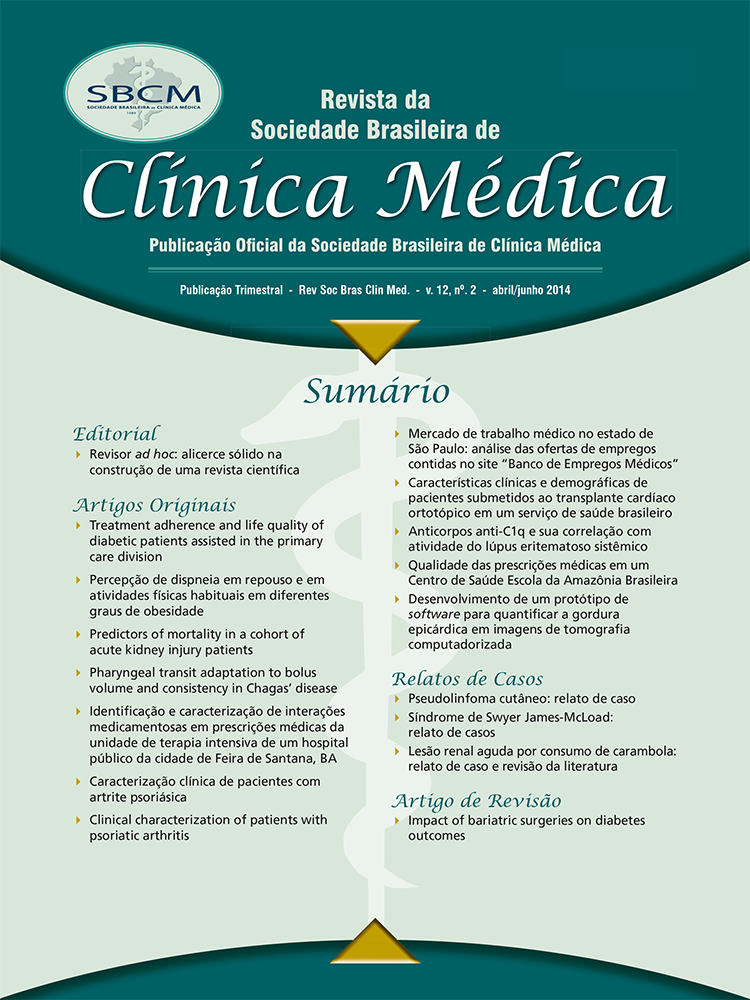Treatment adherence and life quality of diabetic patients assisted in the primary care division
Main Article Content
Resumo
BACKGROUND AND OBJECTIVE: is study sought to evaluate the association between treatment adherence and life quality of diabetic patients assisted in Primary Health Care Units of four cities of Alagoas. METHODS: It was an observational study based on a quantitative approach of transversal investigation. Data came from diabetic patients who were helped out in Primary Health Care Units of the Health Public System of Alagoas/Brazil, from December 2009 to July 2010, in four cities of the state and through the application of socioeconomic and demographic questionnaires and the Morisky-Green and World Health Organization Quality of Life BREF (WHOQOL-BREF) tests. For the analysis, it was used the resources of the Epi Info program. RESULTS: e sample consisted of 711 diabetic patients, predominantly female (71%). e mean age was 61.1, the majority declared to be married, having an average of 4.5 live children. Most were of low education and did not perform any paid activity; 43.4% live with a Brazilian minimum wage or less. It was observed that 61.5% of the population studied was diagnosed with the disease for more than ve years. e study showed a better life quality in the social domain of WHOQOL-BREF. According to the Morisky-Green test, there was a higher frequency of patients with an intermediate class of adherence. e study also showed a good adherence to the treatment and a satisfactory evaluation for the general life quality of the population and an association between these two factors. CONCLUSION: ere was better correlation between adherence and the quality of life in the social field.
Article Details
Declaração de Direito Autoral
Eu (nome do autor responsável) _______________________________________________ declaro que o presente artigo intitulado ___________________________________é original, não tendo sido submetido à publicação em qualquer outro periódico nacional ou internacional, quer seja em parte ou em sua totalidade. Declaro, ainda, que uma vez publicado na revista Revista da Sociedade Brasileira de Clinica Médica, editada pela Sociedade Brasileira de Clínica Médica, o mesmo jamais será submetido por um dos demais co-autores a qualquer outro meio de divulgação científica impressa ou eletrônica.
Por meio deste instrumento, em meu nome e dos demais co-autores, cedo os direitos autorais do referido artigo à Revista da Sociedade Brasileira de Clinica Médica, e declaro estar ciente de que a não observância deste compromisso submeterá o infrator a sanções e penas previstas na Lei de Proteção de Direitos Autorias (n 9610 19 de fevereiro de 1998) que altera, atualiza e consolida a legislação sobre direitos autorais e dá outras providências. Disponível em: http://www.planalto.gov.br/ccivil_03/leis/l9610.htm
|
_________________________ |
___________________ |
|
Local, data |
Assinatura |
SOCIEDADE BRASILEIRA DE CLÍNICA MÉDICA
CNPJ/MF 062.279.617/0001-45
Rua Botucatu, nº 572, cj. 112, São Paulo, SP
Download da Declaração de Direito Autoral.
